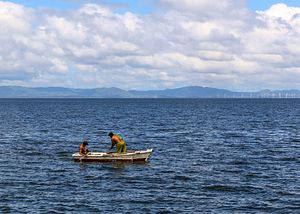Fisherman Anuar Sanchez remembers the day six years ago when the Nicaraguan government announced a $50 billion plan to build an interoceanic canal that would rival Panama’s. Sanchez lives in San Miguelito, a small village on the eastern shore of Lake Nicaragua located in one of the 10 municipalities within the canal’s planned construction zone.
“In the beginning, many residents were overwhelmingly for the canal, but when they learned more about the details of the project and its environmental impact to the protected San Miguelito wetlands, support for it dropped significantly,” Sanchez said. “People weren’t impressed with being forced to relocate, lose their farms and their land.”
But concerns over the 278-kilometer Nicaragua Interoceanic Grand Canal’s environmental impact have been eclipsed by uncertainty about the viability of the project itself. The contract between the Nicaraguan government and the canal’s financial backer, Chinese billionaire Wang Jing, is set to expire September 12, but construction hasn’t begun.
In 2014, Congressman Eliseo Nunez of the Independent Liberal Party called the project “a propaganda game, a media show to continue generating false hopes of future prosperity among Nicaraguans.”
In May, Nicaraguan newspaper La Prensa reported that Nicaraguan President Daniel Ortega had given Wang and his company, HKND Group, a six-year deadline to obtain financing to develop the canal. If HKND failed to do so by June 14, 2019, the Nicaraguan government would be required to pull out of the deal and the contract would expire in 90 days. But as the September expiration date loomed, the government and HKND Group remained mute on the issue.
This changed on August 14. For two years, there was outright silence about the project from the Nicaraguan government, but last Wednesday, President Daniel Ortega announced in a speech to naval forces that “there is our commitment to continue working for the construction of the canal. We have not renounced [the canal project], on the contrary we have, historically, the commitment to make the canal a reality for Nicaragua.”
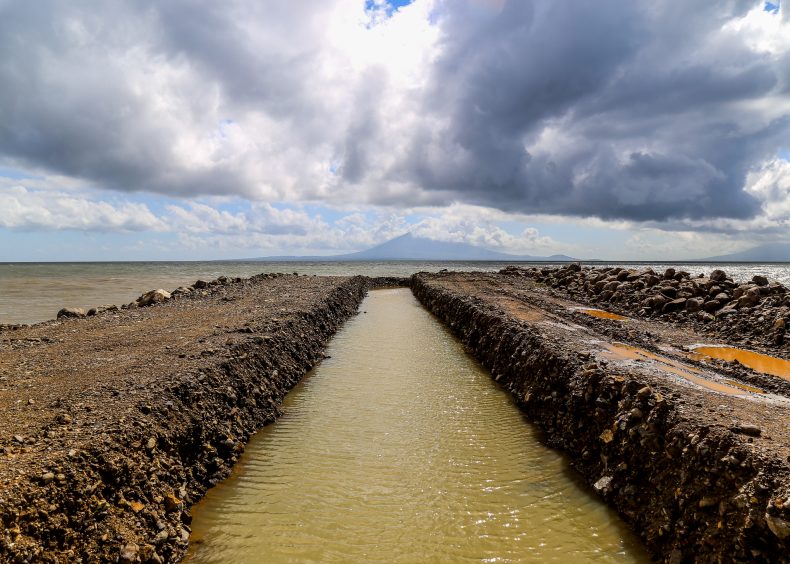
On the western side of the lake, the village of Obrajuelo was slated to be the planned Pacific entry point into the lake for the canal. Photo by Nicholas Muller.
In April, the U.S. Treasury Office of Foreign Assets Control (OFAC) in a press release deemed the canal project a “means to launder money” and put sanctions on three Nicaraguan entities. The sanctioned entities included two officials – Laureano Ortega Murillo, the son of President Ortega, and Vice President Rosario Murillo, Ortegas’s wife – and Banco Corporativo SA (BanCorp), a Nicaraguan bank.
In the press release OFAC says, “Despite the project’s loss of momentum, Ortega regime figures, including Laureano, continue to use the Nicaragua Grand Canal Company as a means to launder money and to acquire property along the planned canal route.”
The Nicaraguan government denies this is the case.
The Nicaraguan government has not issued any further comments about the status of the project. In response to a request for a comment last week on the status of the canal, Paul Oquist, the minister-private secretary for national policies of President Daniel Ortega, and also the executive secretary of the Commission of the Nicaraguan Grand Interoceanic Canal, replied by email that “it is premature at this point in time.” Attempts to reach HKND have been so far unsuccessful. The company has not given any recent public comments and its website is currently unavailable.
“Their policy [the Nicaraguan government] is not to give interviews to independent media. They only use their official media,” says Jorge Huete-Pérez, a University of Central America professor and member of Nicaragua’s Academy of Sciences.
Oquist has also been Nicaragua’s chief climate negotiator and in February 2018, he was named co-chair of the Green Climate Fund shortly after it reversed its opposition to joining the Paris climate accord. He currently sits as the representative of Developing Country Parties from the Latin American and the Caribbean States on the fund as a board member.
According to Huete-Pérez, Oquist’s appointment was seriously contested by many Nicaraguan green NGOs and has come under controversy for its questionable timing. Raul Delgado, the lead climate change specialist at the Inter-American Development Bank, told Reuters in 2017 that joining the Paris accord could open the door for Nicaragua to access money from the Green Climate Fund and other international pots. “It’s a good time for them to join.”
Ortega’s surprise announcement last week suggests the canal project remains alive, and has not been cancelled. Meanwhile, ordinary Nicaraguans continue to wonder what it will mean for their land, livelihood, and ecosystems.
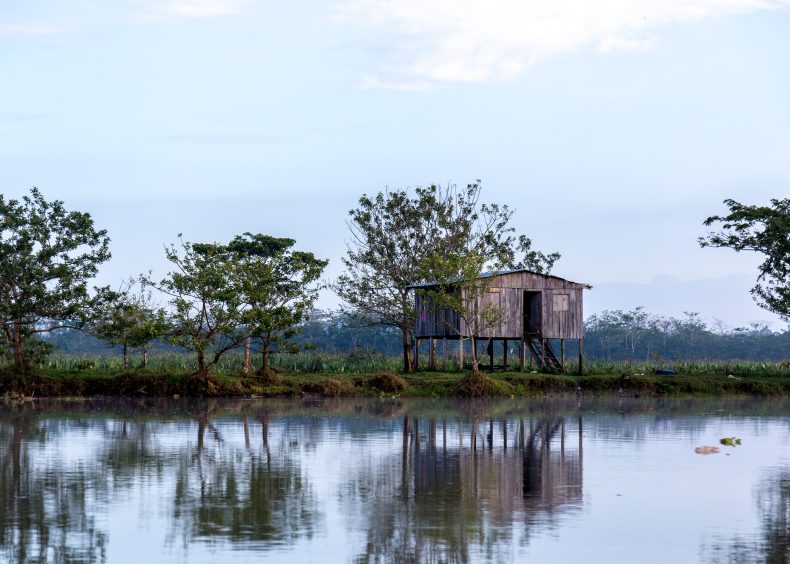
A view over the point Rio San Juan flows into Lake Nicaragua from the town of San Carlos. Photo by Nicholas Muller.
Development Promises
Ortega and Wang announced the deal to build one of the world’s most ambitious and expensive engineering projects on June 13, 2013. The agreement was for HKND, then based in Hong Kong, to construct and operate the Nicaragua canal for the first 50 years, and have the ability to renew the contract for another 50.
The canal was set to be completed by the end of 2019 at a total cost of $50 billion, three times Nicaragua’s GDP ($13.2 billion in 2018). As of 2018, a quarter (24.9 percent) of Nicaraguans lived in poverty, and Ortega promised the canal would mean huge, transformational economic development throughout the country.
For people like Sanchez in the struggling fishing village of San Miguelito, it seemed like a godsend in a place where subsistence farming and fishing are the main ways to eke out a living.
But Sanchez says people in San Miguelito were constantly pressured by authorities posted in the town to support the project and to keep silent about any environmental concerns they had.
The wetlands around Lake Nicaragua are teeming with one of the highest levels of biodiversity in Central America and are part of the Rio San Juan Biosphere Reserve. The area is protected by the Ramsar Convention, an international treaty for the conservation of wetlands around the world. Its rich network of rivers and estuaries are home to dozens of species of birds and endangered animals. Sanchez worried the canal could have a negative impact on the fragile ecosystem, and had seen similar projects do just that in the past.
In the 1950s, a promising fishing boom enabled hundreds of commercial fishermen to fish thousands of bull sharks from the mouth of the nearby San Juan River. Later in the 1970s during the Somoza dictatorship, it delivered a concession to a South Korean fishing company to industrially fish. Japanese and Korean companies used fishing nets to capture sharks and sawfish. A fish processing plant was built, and while it initially brought in huge amounts of money, the projects ran dry after the shark population was decimated by overfishing.
Local specialist Salvador Montenegro confirms this, telling The Diplomat, “Although scientists such as Ignacio Astorqui and others initially thought that the Lake Nicaragua sharks was a separate species, recent studies have shown that they are in fact bull sharks. They are able to jump upstream traveling up the San Juan River, which connects the lake to the Caribbean Sea.”
Huete-Pérez adds, “Eden Pastora, one of Ortega’s closest government officials, now in charge of dredging the San Juan River, was also heavily involved in this business.”
“To me this clearly shows the disregard that these officials have shown and continue to show for the environment,” says Huete-Pérez.
Sanchez says he fears communities like his would have met a similar fate if the construction of the canal were to proceed: Short-term economic gains but irreparable damage to the environment that would leave them with little to show for the project in the long term.
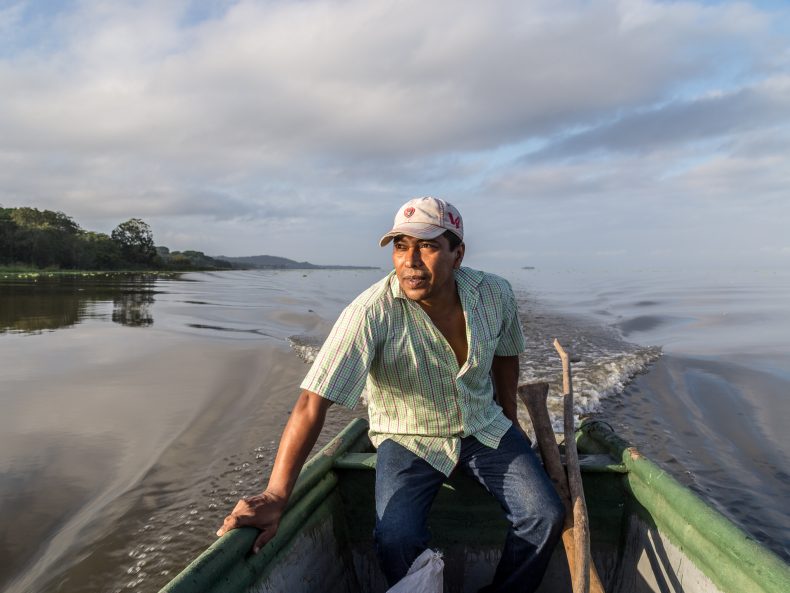
Anuar Sanchez, a fisherman in San Miguelito, says people were split 50-50 on the support of the canal. He says there was very little information about the process and what happened.
Uncertainty Over Land
Since the canal project was announced, there has been a huge range of estimates of the projected number of people who could be displaced by the project, from 27,000 to 120,000. In an emailed response by Huete-Pérez, he says the numbers they used in their latest report were based on the final information provided by the study conducted by British firm ERM, and the Chinese company in their latest study.
“The environmental and human toll are significant. There would be significant impacts likely on Lake Nicaragua, affecting 93,800 hectares of terrestrial ecosystems and 18,800 hectares of tropical rainforest in the Mesoamerican Biological Corridor, as well as the displacement of over 30,000 people,” says Huete-Pérez.
Huete-Pérez says the Humboldt Center and other environmental groups have put the estimate even higher. “The announced route of the canal will directly affect seven protected areas and would mean the destruction of 200,000 hectares of diverse forests (around half a million acres). Definitely the ecological and social costs of the Chinese Canal project are way too high. At any rate, that is an irreparable loss of natural assets which provides incalculable eco-systemic services.”
“In regards to the displacement, they [Humboldt] also estimate that around 120,000 people would be displaced, but the entire population of the 10 municipalities affected is approximately 300,000 people.”
Since then, people living in the path of the canal have reported various forms of harassment and intimidation from the government, according to a report from Amnesty International and reporting from the Guardian, which described excessive force by the police, violence, and unlawful detentions.
Global Witness, a human rights group focused on natural resource-related conflict and corruption and associated environmental and human rights abuses, ranked Nicaragua as the most dangerous country for environmental activists per capita in 2016.
Now, people living in the proposed canal’s path face the uncertainty of whether they will be able to keep their land or will still be required to cede it.
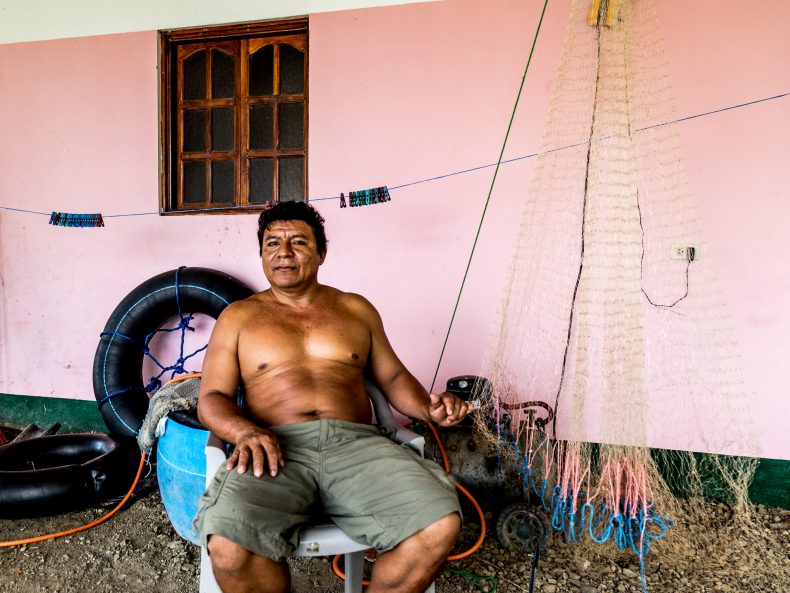
In Obrajuelo, a few miles from Rivas on the shores of Lake Nicaragua, the house of Moise Flores, a long-time fisherman, sits on the edge of what would have been the entrance to the canal crossing Lake Nicaragua.
In Obrajuelo, on the western shore of Lake Nicaragua, Moise Flores and his family live in limbo. The fisherman’s family home sits on the edge of what would have been the entrance to where the canal was planned to be built across Lake Nicaragua. According to Flores, protests in opposition to the canal started in his village approximately 20 months ago. They then spread to the nearby towns of San Jorge and Rivas and to the capital of Managua.
“People are afraid to speak. The government doesn’t care about us. The deal was made exclusively between the Chinese company and Ortega,” Flores said.
Flores said Chinese workers came to his house on the lake shore to do initial surveying and informed his family that the land would be used in the canal’s construction. Families living along the route would throw stones at the Chinese delegations who arrived with police and military escorts to villages like his to take measurements, according to Flores and reports by Nicaragua’s La Prensa.
Flores said he and others in Obrajuelo were offered a meager $250 for each hectare of land, not including their houses. Most refused, but were told they would have to leave. A policy known as Law 840 was passed that allowed for the expropriation of properties that were deemed necessary to the canal’s construction, sparking protests from citizens who want to see the law repealed. According to Bloomberg reports, the Chinese company said they would offer “fair market value” for properties.
Flores was worried he would be forced off of his land and lose his livelihood as a fisherman.
“The path of the canal would have split the lake in half, blocking fish coming from the San Juan River and entering into Lake Nicaragua,” Flores said. Plans were to dredge the lake several meters deep, the canal bisecting it. Flores added that the agreement in the legislation would have prevented Flores and other fishermen from entering the lake to fish for years as it would be directly in the canal zone.
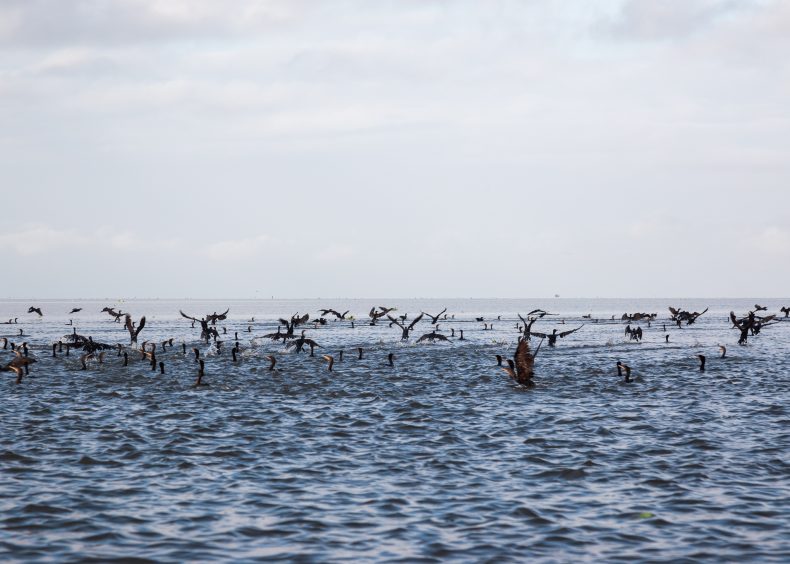
Hundreds of cormorants in the San Miguelito wetlands on Lake Nicaragua. The wetlands seen here on the eastern shore of Lake Nicaragua may be threatened by the construction of a massive cross-country canal, some scientists and environmentalists say. The impact of canal construction on the environment has been the subject of intense debate in Nicaragua. Photo by Nicholas Muller.
A Lasting Environmental Toll
According to Huete-Perez of the Nicaraguan Academy of Sciences, construction of the canal would put an estimated 250,000 to 500,000 acres of tropical forest and wetlands at risk for destruction. The proposed route directly bisects numerous government protected areas (National System of Protected Areas) of biodiversity including the Solentiname Archipelago, the Cerro Silva Natural Reserve, and the Río and San Juan Biosphere Reserves. The country is already considered one of the most vulnerable to the effects of climate change in Central America, according to UNDP.
ERM, a British research consultancy, was hired by the Nicaraguan government and HKND to conduct a study of the proposed canal project. Manuel Coronel Kautz, the president of Nicaragua’s Grand Canal Authority, said the study’s purpose was to “provide an objective, current assessment based on science.”
The resulting study, however, was criticized as being “scientifically weak.”
Steps were promised to protect the environment during the construction process, but environmental groups say it’s not enough.
In Ortega’s latest speech, he said that they are currently “in a phase of preparing environmental studies again, which had already been submitted but adjustments had to be made.”
The Cocibolca Organization, an environmental organization with a special focus on conservation that has chiefly opposed the project, says its own study determined that “the canal route will impact seven nationally and internationally protected areas, which will make the Mesoamerican biological corridor unfeasible and will have huge consequences on biodiversity.”
Although the future of the canal project itself is unclear, the conflict it sparked between Nicaragua’s indigenous and Afro-descendant communities and the government is very much alive.
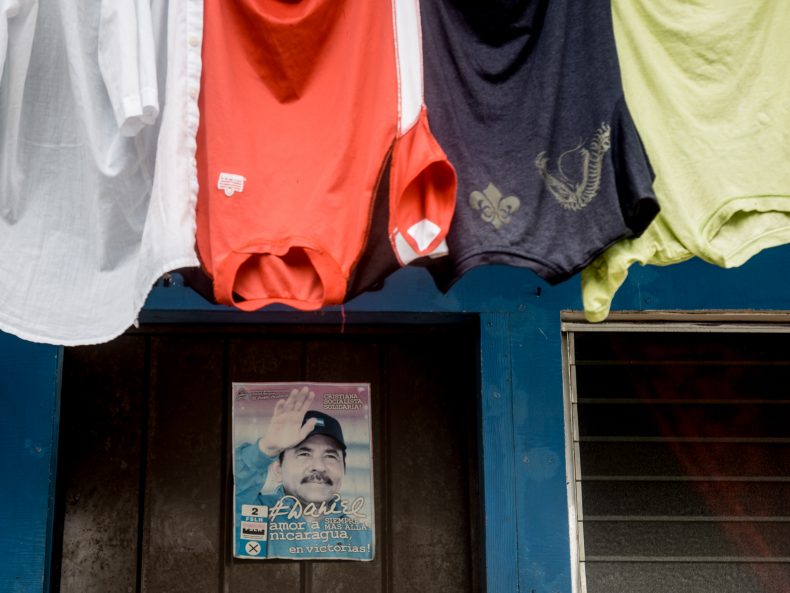
A poster of President Daniel Ortega on a new house built for Rama residents on Rama Cay where some were relocated after the plans to build on Rama autonomous land. Residents are split in terms of their support and opposition to the Nicaragua Canal here. Photo by Nicholas Muller.
Whitewell Omier, 75, is an elder in the Rama tribe living on Rama Cay. He opposes the canal project.
“The cost would have been huge and we wouldn’t have benefited from it for at least 50 years while we would be removed from our land, our livelihoods destroyed, and our ecosystem permanently and irreparably altered,” Omier said. “We didn’t want the canal and don’t know what’s going to happen in the future, but [we] are preparing for it. We were not consulted about the project and the government didn’t know how to explain what benefit the Rama would get from this development.”
Under the original agreement, Wang’s HKND group was to be handed complete rights to use the land, air, water, maritime spaces, and natural resources of the country in the canal zone. It would also be able to use assets from the Nicaraguan government and the country’s central bank.
But in October of 2015, the prospects for financing the canal began to dwindle when it became public that Wang had lost 85 percent of his fortune due to a massive downturn in his Xinwei-owned shares, Bloomberg reported. Wang’s net worth subsequently dropped from $10.2 billion dollars to $1.1 billion. It is unclear today where Wang lives or what the state of his finances are.
In 2018, HKND abandoned their offices in central Hong Kong. According to Bloomberg: “A representative for Wang said by phone that the move reflected a ‘change of strategy,’ and added that the company will maintain operations in Hong Kong, but declined to provide details about the new location. The company’s registered address is an accounting office in Kowloon. HKND didn’t respond to requests for additional comment.” Wang has had legal issues in Ukraine and in several other projects he has been involved with around the world.
The Nicaraguan government continues to allocate a budget for the canal authority on paper. But communities across the country are waiting to see what happens as the cancellation deadline looms.
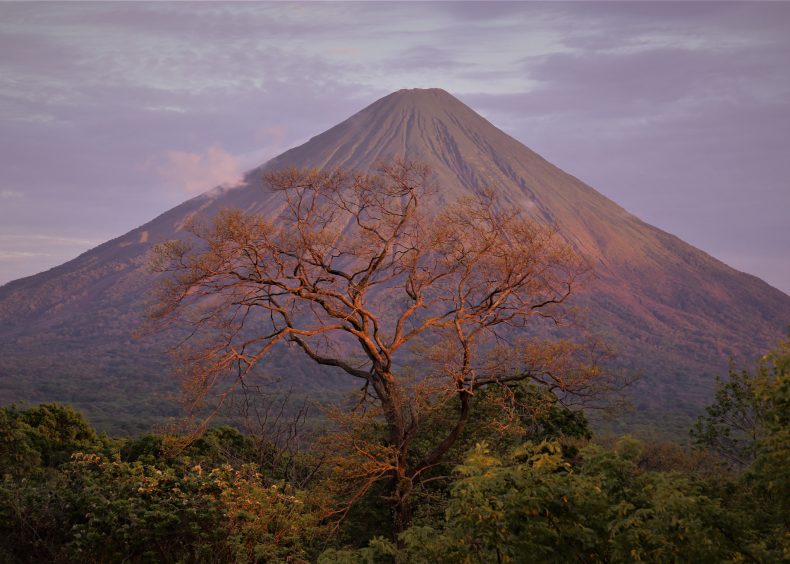
A morning view of volcano Concepción on Ometepe Island in the middle of Lake Nicaragua. Ometepe’s protected reserve is blessed with several ecosystems comprised of wetlands, tropical rainforests, and fog forests which possess the highest conservation value in all of Nicaragua. Environmentalists have deemed there would be widespread and irreparable destruction to the island, Lake Nicaragua, and its connected ecosystems should the canal be built. Photo by Nicholas Muller.
Nicholas Muller is an American photojournalist and writer.













